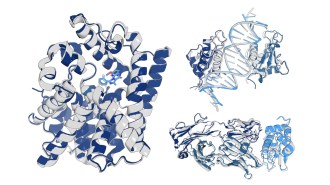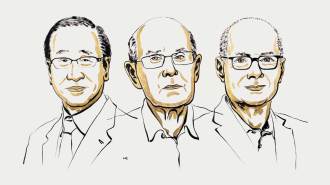The development of the lithium-ion battery has won the chemistry Nobel Prize
Three scientists win for helping create the lightweight, rechargeable devices
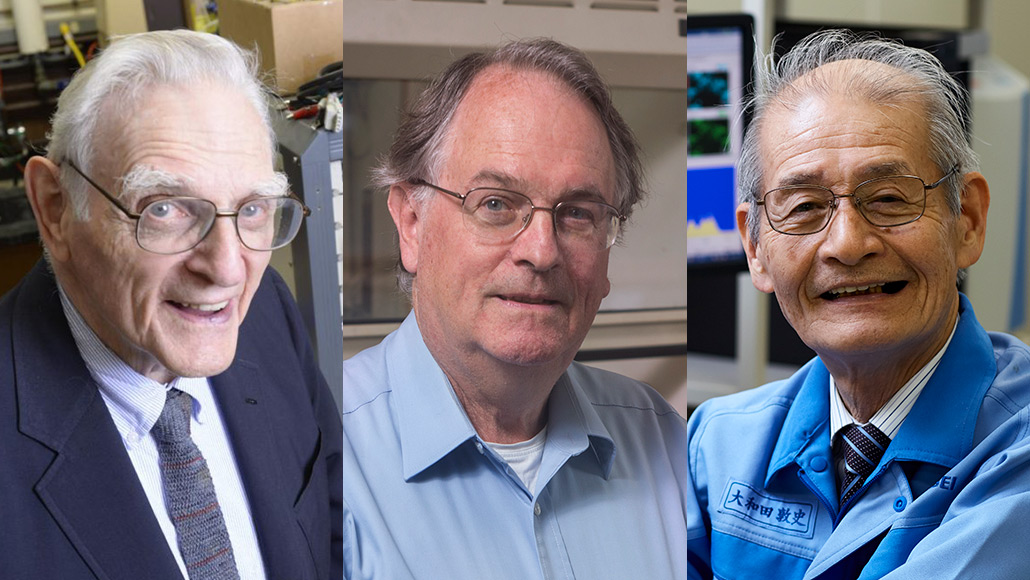
Three scientists, John B. Goodenough, M. Stanley Whittingham and Akira Yoshino (from left), have won the Nobel Prize in chemistry for their work on lithium-ion batteries.
From left: Cockrell School of Engineering/Univ. of Texas at Austin; Jonathan Cohen/Binghamton Univ.; Heinz Troll/European Patent Office
Creating a rechargeable world has earned three scientists the 2019 Nobel Prize in chemistry.
John B. Goodenough of the University of Texas at Austin, M. Stanley Whittingham of Binghamton University in New York and Akira Yoshino of the Asahi Kasei Corporation in Tokyo and Meijo University in Nagoya, Japan, won for their contributions to developing lithium-ion batteries.
These lightweight, rechargeable batteries power everything from portable electronics to electric cars and bicycles, and provide a way to store energy from renewable but transient energy sources, like sunlight and wind.
“This battery has had a dramatic impact on our society,” Olof Ramström, a chemist at the University of Massachusetts Lowell and member of the 2019 Nobel Committee for chemistry, said October 9 during the announcement of the prize by the Royal Swedish Academy of Sciences in Stockholm. “It’s clear that the discoveries of our three laureates really made this possible. It’s really been to the very best benefit of humankind.”
These newly minted laureates will equally share the prize of 9 million Swedish kronor (about $900,000). Goodenough, age 97, is the oldest person to ever receive a Nobel Prize.
“John is an amazing scientist, with incredible intuition, and a great person, who has inspired generations of scientists and engineers with his positive attitude, honesty and boundless curiosity,” says Yang Shao-Horn, a chemist and engineer at MIT.
Batteries store electrical energy in the form of chemical energy, and have three main parts: two electrodes (the anode or negative electrode, and the cathode, positive) and the electrolyte, which helps ions move inside the battery. Chemical reactions at one end of the battery, in the anode, release electrons that travel through a circuit to the other end and are accepted by the cathode, forming a current that can power a flashlight, cell phone or car.
Alessandro Volta demonstrated the first electric battery in 1800, and scientists have been clamoring to build better batteries ever since — mostly by searching for anode materials that can release more electrons and for cathode materials that can better attract them.
In the 1970s, Whittingham began experimenting with lithium as an anode material, because it’s so lightweight, and it readily releases electrons and positively charged lithium ions. His rechargeable battery scheme used a cathode made of titanium disulfide, which contains many layers that can house lithium ions released from the anode. While working with the energy company Exxon, Whittingham combined lithium metal and titanium disulfide in a battery, creating the first lithium battery. His battery boasted 2 volts.
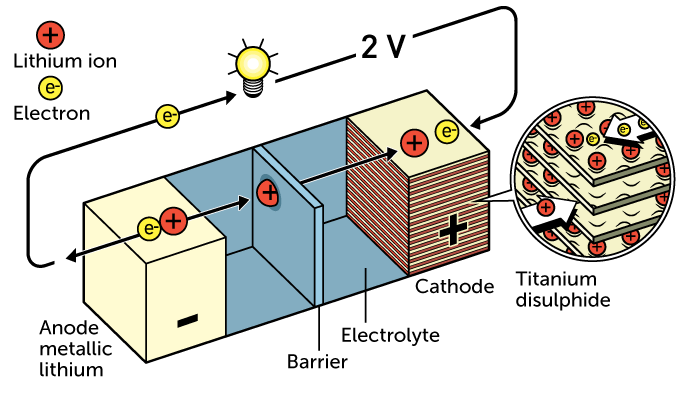
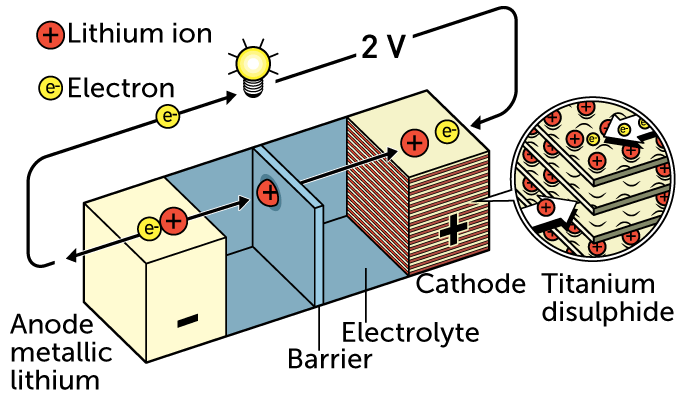
But the lithium metal that comprised Whittingham’s original anode was liable to form defects called dendrites (SN: 10/26/17) that could cause a battery to short-circuit and explode. So developers added aluminum to the lithium anode and swapped out the electrolyte substance sandwiched between the anode and cathode to make a battery safer for everyday use.
Then, in the late 1970s and early 1980s, Goodenough sought to improve on Whittingham’s cathode by using cobalt oxide instead. This material was layered like titanium disulfide, but could house even more ions within its layers. Goodenough’s innovation doubled the voltage potential of lithium batteries to 4 volts, “a gigantic leap in the battery world,” said Ramström during the news conference. (Many smartphones today use lithium batteries with voltages around 4 volts.) But the battery still used lithium metal as an anode.
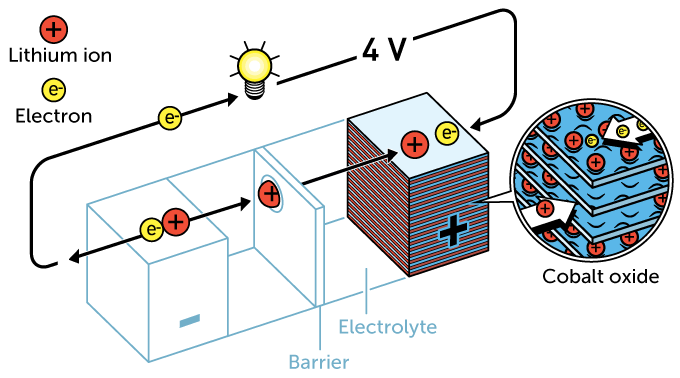
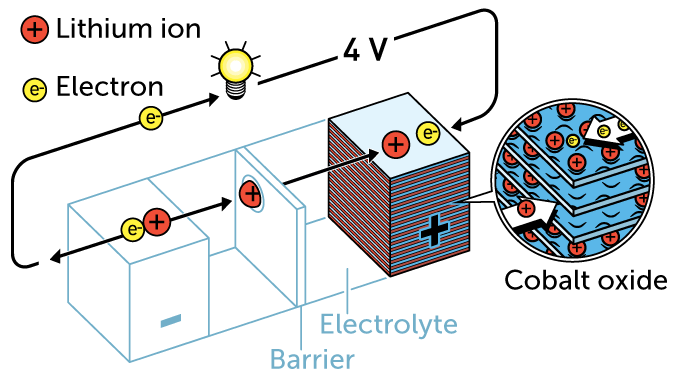
In 1985, Yoshino explored using a by-product of oil production called petroleum coke as an anode. Like cobalt oxide, petroleum coke was finely layered, and while not made of lithium, it could store lithium ions when charged. When paired with Goodenough’s cathode, Yoshino’s anode material resulted in an even safer, more durable, lightweight and rechargeable 4-volt battery. That basic design was used in the first commercially available lithium-ion batteries in 1991.
“Curiosity was the main driving force for me,” said Yoshino during the news conference in Stockholm.
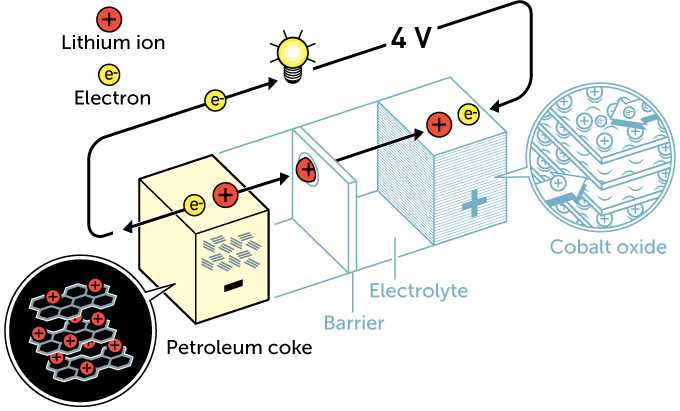
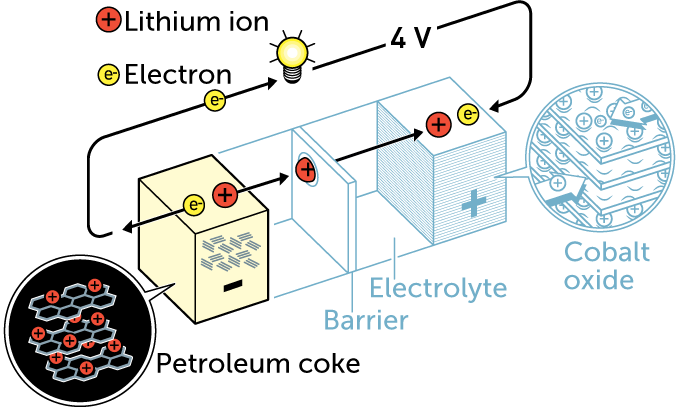
These early lithium-ion batteries offered about twice as much energy as the next best option, and could be charged hundreds of times before their performance began to suffer.
“It’s very good, feeling that one’s research actually came out with something. It didn’t just fall, as they say, in the wastebasket,” said Whittingham in a teleconference on October 9, immediately following a last-minute dinner in his honor in Germany, where he was traveling at the time.
The Nobel Prize announcement is “really thrilling for the battery community,” says Kelsey Hatzell, a battery researcher at Vanderbilt University in Nashville. “Stan and Akira and John’s work is so significant.… You can’t imagine going through your daily life without using half a dozen different devices that use lithium-ion batteries,” including phones, computers and other communication devices.
“I’m extremely happy that my work has helped people’s ability to communicate around the world,” said Goodenough in a news conference in London on October 9. “We need to build relationships, not walls, and I’m happy that people use this work for good and not for evil.”
When he was asked if he expected to win and what he’d do with the prize money, Goodenough replied, “I didn’t expect anything! It’s been a very eventful day, that’s all I can say, and I’m appreciative to everyone…. My share of the winnings will go to my university to support people who work there.”
Goodenough may not have anticipated this honor, but other researchers have long considered him a shoo-in for the chemistry Nobel. “People in the electrochemistry field … have put him number one on our [Nobel prediction] lists for years and years and years and years,” says chemist Amanda Morris of Virginia Tech in Blacksburg. “It was really great to see him and the other recipients finally get recognized.”
Lithium-ion batteries now perform much better than those on the market in 1991. “Over the past two decades or more, researchers have been working very hard to boost [rechargeable batteries’] energy. The energy has doubled — even tripled, in some cases, and the cycle life has improved greatly,” says Shao-Horn. Today, you can recharge these batteries thousands of times. The batteries have also gotten safer and cheaper (SN: 1/13/17).
The invention of lithium-ion batteries “is such a great example of improving people’s lives through the power of chemistry,” says biochemist Bonnie Charpentier, president of the American Chemical Society and senior vice president of regulatory, quality and drug safety at biopharmaceutical company Cytokinetics, Inc.
What’s more, “this is the international year of the periodic table of elements, so it’s fun to have a Nobel Prize that actually names an element,” she says (SN: 1/8/19).
Researchers are now developing different types of rechargeable lithium batteries, such as lithium-oxygen (SN: 8/23/18) or lithium-sulfur (SN: 1/9/17), that could pack more power in a more lightweight package than traditional lithium-ion batteries. Other scientists, Hatzell says, are trying to figure out how to efficiently recycle lithium-ion batteries or build batteries using more sustainable resources (SN: 5/7/19) than today’s power cells.


